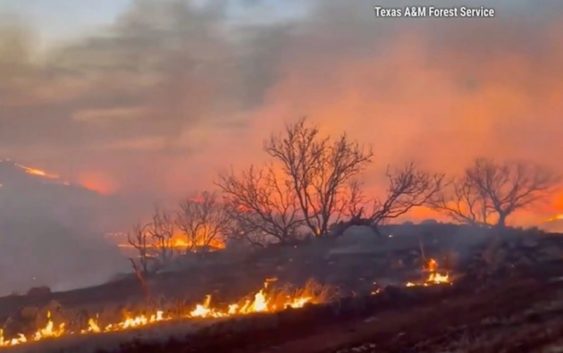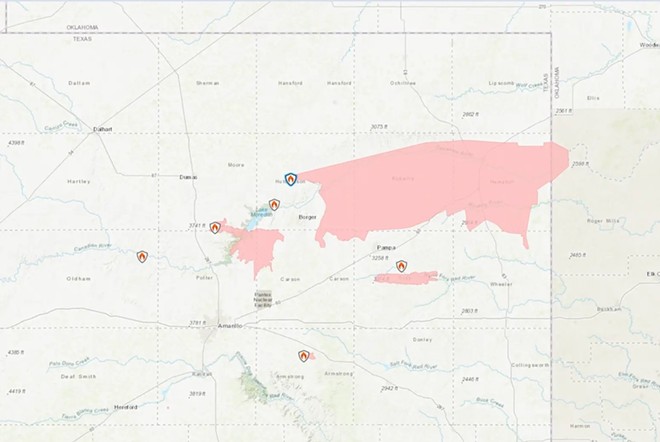- Cold front could trigger severe weather in Houston area this weekend | Timeline for potential storms
- Severe weather possible for Houston this weekend | Weather Impact Alert issued
- Impact Plastics not responsible for workers killed in Helene flooding, TOSHA says
- 'A little emotional': Hurricanes equipment manager got seconds in goal, memory to last a lifetime
- WMO retires three hurricane names after devastating 2024 season
Texas firefighters battling massive Panhandle wildfires, including second largest in state’s history

Screenshot from Texas A&M Forest Service video
Wildfires have erupted in the Texas Panhandle this week.
Sign up for The Brief, The Texas Tribune’s daily newsletter that keeps readers up to speed on the most essential Texas news.
LUBBOCK — Firefighters are still working to extinguish five raging wildfires in the Texas Panhandle that have already collectively burned nearly 575,000 acres, an amount of land that’s roughly 40% larger than Houston, the nation’s fourth most populous city.
The Smokehouse Creek fire, which started Monday afternoon, grew from 100,000 to 500,000 acres within 24 hours, according to Texas A&M Forest Service. It is the second largest wildfire in Texas history, and was still not contained Wednesday morning.
Gov. Greg Abbott issued a disaster declaration covering 60 counties in response to the wildfire activity, calling for the Texas Division of Emergency Management to send additional resources and firefighters to the Panhandle.

Texas A&M Forest Service
Screenshot of a map of the fires raging in the Texas Panhandle taken at 10:22 A.M. on Wednesday, Feb. 28, 2024. The largest, the Smokehouse Creek Fire, is the second largest wildfire in Texas history.
Residents from Canadian, a small town of about 2,300 people that was ravaged by the largest fire of the bunch, were allowed to return to their homes Wednesday.
Officials ordered nearly 5,000 residents in the Panhandle cities of Canadian, Fritch and Glazier to either evacuate or shelter in place Tuesday as the separate wildfires engulfed the region. Videos on social media showed the chaotic scenes of the fire spreading and herds of cattle fleeing. Residents in Hemphill County, where Canadian is, were initially told to evacuate as the Smokehouse Creek fire spread and burned more than 250,000 acres within a day. As firefighters worked to contain the fire in Canadian, about 100 miles northeast of Amarillo, evacuation efforts hit a snag as the main roadway was blocked by the fire.
While Amarillo has largely been able to avoid the fires, aside from an evacuation order in nearby Mesilla Park, the city’s air quality has been impacted. The National Weather Service of Amarillo warned residents the Interstate 40 corridor had poor air quality and that they should keep themselves and pets indoors as much as possible.
The dense smell of smoke from the fires reached Lubbock, 120 miles south, and the rest of the region Tuesday night, carried in by winds from a cold front. Lubbock’s National Weather Service warned residents to expect reduced visibilities.
City officials in Borger said the fires have slowed down as a result of decreased wind speeds, but Highway 136 between Borger and Amarillo is still closed. Residents were encouraged to avoid traveling through the area as much as possible to give emergency responders the space to work on controlling the fire.
Officials also said residents of Fritch could not return yet, as many neighborhoods are unsafe and without power or water. Residents can find shelter at the Johnson Park Youth Center in Borger in the meantime.
Shortly after the mandatory order was announced, the Hemphill County Sheriff’s Office shared on social media that Highway 60/83 was shut down. The sheriff’s office instructed residents to go to the gym at Canadian High School to shelter in place.
“There were earlier evacuation orders, but it got to the point where the fire was close enough that it was no longer safe to travel on those roads,” said Kari Hines, a public information officer for Texas A&M Forest Service. “It’s safer to stay inside structures, at least while the main body of the fire passes.”
Hines said crews have responded from across the state and are working in long shifts to contain the fire before taking breaks to rest.
Photos and videos on social media show the small towns surrounded by smoke billowing into the air, turning the sky a brown hue, as the fires continued.
The High Plains region was under a red flag warning to start the week, as warmer temperatures were expected along with strong winds. According to the Texas A&M Forest Service, the Smokehouse Creek fire started in tall grasses, and wind gusts that ranged from 40-50 miles per hour pushed the fire towards Pampa, about 40 miles southeast.
Wildfire risk is generally expected to increase across the state as climate change progresses because the landscape will be drier and there will be more vegetation to burn, according to Texas State Climatologist John Nielsen-Gammon’s 2021 report on extreme weather.
Those effects will still vary regionally, according to Nielsen-Gammon’s findings. In the next two decades, the chance for wildfires may increase more slowly in the Panhandle and Far West Texas because there will be less plant matter to burn. But more areas of the state to the east may begin to suffer from wildfires as the plants there dry up in the heat.
Emily Foxhall contributed to this report.
This article originally appeared in the Texas Tribune.
The Texas Tribune is a member-supported, nonpartisan newsroom informing and engaging Texans on state politics and policy. Learn more at texastribune.org.
Subscribe to SA Current newsletters.
Follow us: Apple News | Google News | NewsBreak | Reddit | Instagram | Facebook | Twitter| Or sign up for our RSS Feed